 |
Book Reviews
The Rise of the Neo-Communist Empire
Atila S. Guimarães
Book review of Lies, Terror and the Rise of the Neo-Communist Empire - Origins and Direction by Toby Westerman (Bloomington, IN: AuthorHouse, 2009), 231 pp.
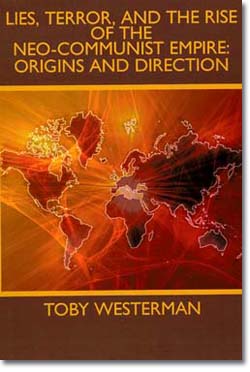
Purchase the book here |
Those who did not fall for the ruse that Communism died will find a valuable tool to support their position in this book. Those who naively believed the myth that John Paul II and Ronald Reagan defeated Communism by giving prestige and money to Lech Walesa will find clear proof in this book that Communism never died - it just changed its face to better advance.
Based on a remarkable amount of confidential information that he takes from his files as an expert in international politics, Mr. Westerman offers his reader a wide-ranging map of contemporary communist activity. This is presented in an attractive style that makes his grave topic read like a detective novel.
The ‘new’ face of Russian Communism
He begins by describing how the bustling communist spy ring was strong - ironically at the same time that Boris Yeltsin delivered his dramatic speech to the U.S. Congress (June 17, 1992), assuring the world that Communism had died and Russia had embraced the social-economic principles of the modern West. The Author specifies that while Yeltsin guaranteed us that “liberty would not be fooled,” around 700,000 communist spies were working around the world to continue the expansion of their ideas.
Many old communist symbols were abandoned, indeed, and many institutions were closed. Not so much because their leaders had changed ideology, but rather because those institutions were bankrupt and the people no longer followed those leaders. While this general failure gave the appearance of a change in ideas, in reality, the Author suggests, it was to invite capitalists to come to Russia and restore its economy. Thenceforth, a surge of Western investments entered the collapsed communist economy and gave it a new life.
Eight years later, however, as that disaster started to be resolved, Vladimir Putin won the elections (March 2000) and again began to rebuild and reinstall the communist institutions that had been abandoned. An ex-KGB agent, Putin is working to restore that infamous agency. The same personnel, the same methods - espionage, persecution, murder - continue to be applied today against those who threaten the government in any way. Significantly - and Westerman documents this quite well - Putin is also longing for the return of the USSR.
Deep down, the West is the facilitator for Communism to continue. This is what is still happening today. Communism continued, but with a metamorphosed face. What is new about this face? In each part of the world, it has its special characteristics.
In Russia, it abandoned the Stalinist-style Communism to revisit the methods of Lenin.
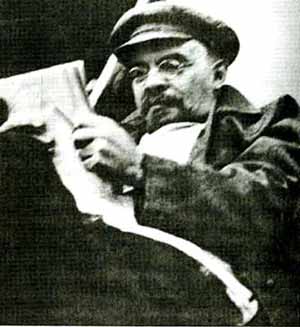
Lenin in 1922, the year he started his new economic policy |
Many persons today have forgotten, but after the 1917 Bolshevik coup in Russia Communism shamefully buckled in its management of the State. Then Lenin introduced his New Economic Policy (NEP), which allowed a limited amount of private property. The adoption of this policy - supported by a good segment of the capitalist media - convinced the West that Communism had failed and that, therefore, the best thing to do was to assist Lenin to repair the damage. We know how that strategy served to sustain Communism.
This same tactic of changing its face was used again later after the fall of the Iron Curtain, Westerman implies.
Points not neglected: Russia never stopped supporting terrorists in Iran, Syria or Venezuela; never stopped reinforcing links with the Soviet-style despots of Kazakhstan, Kyrgyzstan, Uzbekistan, Turkmenistan, Tajikistan, North Korea and Cuba; it never stopped pressuring Ukraine and Georgia to return to its arena of influence. This is to mention just a few facts normally silenced by the media that the Author brings to light in his book.
A “new” Communism with Chinese characteristics
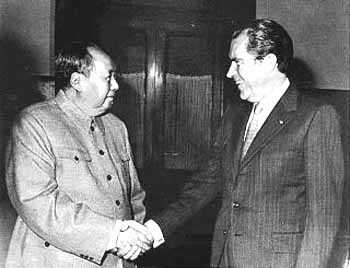
Nixon's trip to Communist China, 1972, opened the doors for the present-day Chinese economic boom |
After having analyzed the “new” face of Communism in Russia, Westerman moves on to China. He first proves that the old myth that Russia and China are adversaries has no substance. Then he analyzes the Nixon-created new Chinese economic boom that is open to the “free market.” In reality, in present-day China the market is controlled by the government and its success is due to three combined factors:
- A constant injection of external money;
- The introductions of the sophisticated technology from the West;
- An enormous internal slave work force.
He also shows how the West is “naïve” to believe that the free-market economy will necessarily defeat Communism in China. The Author proves that precisely the opposite is true. The West is providing China the means to become a giant that is already threatening the United States economically and heading toward threatening it militarily.
How has the U.S. responded to this menace? The Bush administration decided that to balance the rapid Chinese growth, the U.S. should channel economic assistance to communist Vietnam and offer it trade priorities…
Communism progresses with elections in Latin America
The Author shows that the new goal of Communism is to implant red governments by means of democratic elections. This is the new face of Communism in Latin America. He analyzes the example of Venezuela in detail, and shows how Hugo Chavez promotes Communism under the name of the Bolivarian Revolution.
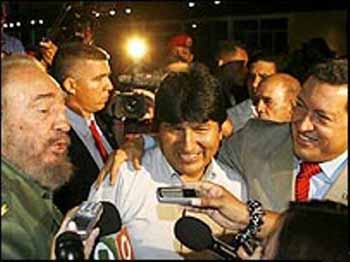
Morales between Castro and Chavez:
Communism makes presidents through elections |
The links between Chavez and the Colombian FARC guerillas are also pointed out, as well as how Chavez helped Rafael Corrêa to be elected president of Ecuador. In dealing with Chavez, he mentions other red presidents who came to power through elections: Evo Morales in Bolivia, Christina Kirchner in Argentina, Luis Inácio da Silva in Brazil and Tabaré Vasquez in Uruguay. Westerman also calls attention to the cordial relations or economic and military treatises of Chavez with Russia, China, Cuba, Nicaragua, North Korea, Syria and Iran. This is part of the new empire to which he refers in the title of his book.
The Author spends sometime emphasizing the danger Cuba represents to the U.S. and substantiates his words with interesting information on the spying activity the communist Island has established to infiltrate the U.S.
Closing up his analysis of “the Latin Red Storm,” he lets his attention fall on the election of Marxist Daniel Ortega in Nicaragua.
Islam and terrorism
A short chapter is dedicated to verify the historical continuity of the Islamic militant opposition to the West and their thousand-year resentment for the Crusades. This cursory description is meant to fill the lacuna in the media, text books and academia on the topic.
Some quick and indirect links are made between present-day terrorism and Communism.
The American left and the media
All the different fronts of present-day Communism have a common enemy: the United States as a representative of Capitalism. They have a strong ally in the American left. Although the Communist Party has little influence in American political life, the same cannot be said regarding the influence of the media and the political left.
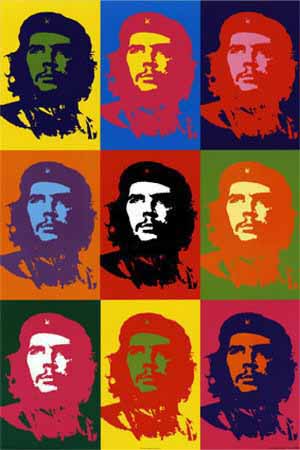
Guevara, a murderer, was transformed into hero by the American media |
As far as the media is concerned, Westerman reproduces historic documentation showing its support for Lenin in Russia, Mao in China, and Castro in Cuba. We always find the same complicity with America’s most dangerous enemy, Communism.
With regard to the left, a strong political voice has been given to communists in the government since the term of Franklin D. Roosevelt. Indeed, several of the most influential members of his cabinet were found to be spies for Moscow. From then on, the red seed took root deeper and deeper into American politics.
To foster Communism in the U.S., an important role is played by movie stars and Hollywood producers who disseminate anti-American heroes such as Che Guevara and promote anti-heros such as the Rosenberg couple - condemned to death for selling atomic secrets to the USSR. The Author points to the “rehabilitation” of this infamous couple as a grave symptom of the weakness of the North American sense of self-defense.
Nor does he dismiss the huge anti-war effort of academia and the pacifist movement pushed by the leftist media that aims to discourage the troops who are giving their lives to save the country by combating terrorism.
This powerful coalition of Americans promoting anti-American sentiment is something not only contradictory and shameful, but most perilous.
The American pacifist platform is also promoted by the new communist leaders previously mentioned. A symbolic example: Hugo Chavez received anti-war celebrity Cindy Sheeman with all honor at his government palace. Afterward, he posed for the cameras with one arm over her and the other around Elma Rosado, the widow of terrorist leader Ojeda Rios of Puerto Rico. Ojeda was killed in 2005 by American agents after a multi-million dollar bank robbery and the downing of eleven National Guard fighter jets.
Chavez and the two women embraced on the stage of the World Social Forum meeting in Caracas. Pacifism and terrorism intertwined in the embrace of Hugo Chavez – a gesture that says a lot…
Westerman ends his work with an appeal for Americans to become aware of what the media is hiding. He also invites them to take action to stop the central enemy he denounced in his work: the American accomplices of Communism.
His book provides a broad, encompassing panorama, as well as many facts and sources worth knowing and historical perspectives that help understand the present-day situation.
You may purchase Lies, Terror and the Rise of the Neo-Communist Empire at International News Analysis.

Posted June 10, 2009

Related Topics of Interest
 Someone Is Listening Someone Is Listening
 Russian Spies: Returning or Never Left? Russian Spies: Returning or Never Left?
 Fidel's Red Club Fidel's Red Club
 The China Threat - Where is the Response? The China Threat - Where is the Response?
 Murder and Spies: A Spy-Catcher's Warning Murder and Spies: A Spy-Catcher's Warning
 Ignoring the Evil of Communism in Cuba Ignoring the Evil of Communism in Cuba

Related Works of Interest
|
|
Book Reviews | Home | Books | CDs | Search | Contact Us | Donate

© 2002-
Tradition in Action, Inc. All Rights Reserved
|
 |
|